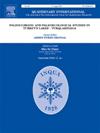Middle and Upper Paleolithic of the southern Pannonian Basin: Lithic assemblages from Petrovaradin Fortress (Novi Sad, Serbia)
IF 1.8
3区 地球科学
Q3 GEOGRAPHY, PHYSICAL
引用次数: 0
Abstract
Rescue excavations of Petrovaradin Fortress in Novi Sad (Serbia), conducted at several different locations, revealed loess layers with Middle and Upper Paleolithic lithic material, which were dated using optically stimulated luminescence (OSL). The c. 90 ka old Layer 2b contained Middle Paleolithic massive bifacially flaked sidescrapers, similar to the types documented in the early Micoquian of the Pannonian Basin. Layer 2a, dated to about 43–40 ka, yielded an artifact assemblage with Levallois and Quina components present, while Layer 1, in the southeastern sector of the site, contained numerous Gravettian artifacts. Based on OSL dating, the Gravettian layer is estimated to be between 31 and 26 thousand years old, aligning with the radiocarbon age of approximately 28 thousand years cal BP. The archaeological materials recovered from the Petrovaradin Fortress site provided completely new insights into the Palaeolithic of the southern Pannonian Basin, showing that Middle Paleolithic industries with bifacial tools, typically found in northern regions, are also present in the southern parts of the basin. The dating results showed that there is a possibility that the Central European Quina industries persisted into the late Middle Paleolithic, just before the appearance of the early Upper Paleolithic. Lastly, the southern Pannonian and Peripannonian areas (where several Gravettian sites have been investigated) were densely populated immediately before the beginning of the Last Glacial Maximum.
潘诺尼亚盆地南部旧石器时代中晚期:来自Petrovaradin要塞(塞尔维亚诺维萨德)的石器组合
在诺维萨德(塞尔维亚)的Petrovaradin要塞的几个不同地点进行的抢救发掘中,发现了旧石器时代中晚期的黄土层,使用光学激发发光(OSL)对其进行了年代测定。约90ka前的2b层包含旧石器时代中期的大块双面片状侧楼,与潘诺尼亚盆地早期Micoquian记录的类型相似。第2a层的年代约为43-40 ka,发现了一个含有勒瓦卢瓦和奎纳成分的人工制品组合,而第1层位于该遗址的东南部,包含了许多格拉维特人工制品。根据OSL测年法,估计重力层的年龄在3.1万年到2.6万年之间,与大约2.8万年的放射性碳年龄(BP)一致。从Petrovaradin要塞遗址中发现的考古材料为潘诺尼亚盆地南部的旧石器时代提供了全新的见解,表明通常在北部地区发现的旧石器时代中期使用双面工具的工业也出现在盆地南部。测年结果表明,中欧的奎纳工业有可能持续到中旧石器时代晚期,就在旧石器时代早期早期出现之前。最后,在末次盛冰期开始之前,潘诺尼亚南部和潘诺尼亚周边地区(已经调查了几个格拉韦特遗址)人口密集。
本文章由计算机程序翻译,如有差异,请以英文原文为准。
求助全文
约1分钟内获得全文
求助全文
来源期刊

Quaternary International
地学-地球科学综合
CiteScore
5.60
自引率
4.50%
发文量
336
审稿时长
3 months
期刊介绍:
Quaternary International is the official journal of the International Union for Quaternary Research. The objectives are to publish a high quality scientific journal under the auspices of the premier Quaternary association that reflects the interdisciplinary nature of INQUA and records recent advances in Quaternary science that appeal to a wide audience.
This series will encompass all the full spectrum of the physical and natural sciences that are commonly employed in solving Quaternary problems. The policy is to publish peer refereed collected research papers from symposia, workshops and meetings sponsored by INQUA. In addition, other organizations may request publication of their collected works pertaining to the Quaternary.
 求助内容:
求助内容: 应助结果提醒方式:
应助结果提醒方式:


